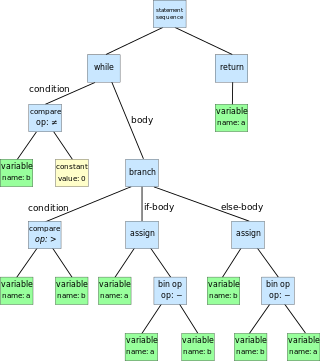In computability theory, Rice's theorem states that all non-trivial semantic properties of programs are undecidable. A semantic property is one about the program's behavior, unlike a syntactic property. A non-trivial property is one which is neither true for every program, nor false for every program.
In computer science, static program analysis is the analysis of computer programs performed without executing them, in contrast with dynamic program analysis, which is performed on programs during their execution in the integrated environment.
In software engineering and computer science, abstraction is the process of generalizing concrete details, such as attributes, away from the study of objects and systems to focus attention on details of greater importance. Abstraction is a fundamental concept in computer science and software engineering, especially within the object-oriented programming paradigm. Examples of this include:

An abstract syntax tree (AST) is a data structure used in computer science to represent the structure of a program or code snippet. It is a tree representation of the abstract syntactic structure of text written in a formal language. Each node of the tree denotes a construct occurring in the text. It is sometimes called just a syntax tree.
In computer science, formal methods are mathematically rigorous techniques for the specification, development, analysis, and verification of software and hardware systems. The use of formal methods for software and hardware design is motivated by the expectation that, as in other engineering disciplines, performing appropriate mathematical analysis can contribute to the reliability and robustness of a design.
In computer programming, a type system is a logical system comprising a set of rules that assigns a property called a type to every term. Usually the terms are various language constructs of a computer program, such as variables, expressions, functions, or modules. A type system dictates the operations that can be performed on a term. For variables, the type system determines the allowed values of that term.
In the context of hardware and software systems, formal verification is the act of proving or disproving the correctness of a system with respect to a certain formal specification or property, using formal methods of mathematics. Formal verification is a key incentive for formal specification of systems, and is at the core of formal methods. It represents an important dimension of analysis and verification in electronic design automation and is one approach to software verification. The use of formal verification enables the highest Evaluation Assurance Level (EAL7) in the framework of common criteria for computer security certification.
SPARK is a formally defined computer programming language based on the Ada programming language, intended for the development of high integrity software used in systems where predictable and highly reliable operation is essential. It facilitates the development of applications that demand safety, security, or business integrity.
This is an alphabetical list of articles pertaining specifically to software engineering.
Dynamic program analysis is the act of analyzing software that involves executing a program – as opposed to static program analysis, which does not execute it.
The DMS Software Reengineering Toolkit is a proprietary set of program transformation tools available for automating custom source program analysis, modification, translation or generation of software systems for arbitrary mixtures of source languages for large scale software systems. DMS was originally motivated by a theory for maintaining designs of software called Design Maintenance Systems. DMS and "Design Maintenance System" are registered trademarks of Semantic Designs.
The ANSI/ISO C Specification Language (ACSL) is a specification language for C programs, using Hoare style pre- and postconditions and invariants, that follows the design by contract paradigm. Specifications are written as C annotation comments to the C program, which hence can be compiled with any C compiler.

CADP is a toolbox for the design of communication protocols and distributed systems. CADP is developed by the CONVECS team at INRIA Rhone-Alpes and connected to various complementary tools. CADP is maintained, regularly improved, and used in many industrial projects.

George Ciprian Necula is a Romanian computer scientist, engineer at Google, and former professor at the University of California, Berkeley who does research in the area of programming languages and software engineering, with a particular focus on software verification and formal methods. He is best known for his Ph.D. thesis work first describing proof-carrying code, a work that received the 2007 SIGPLAN Most Influential POPL Paper Award.

Device drivers are programs which allow software or higher-level computer programs to interact with a hardware device. These software components act as a link between the devices and the operating systems, communicating with each of these systems and executing commands. They provide an abstraction layer for the software above and also mediate the communication between the operating system kernel and the devices below.
The following outline is provided as an overview of and topical guide to C++:
AbsInt is a software-development tools vendor based in Saarbrücken, Germany. The company was founded in 1998 as a technology spin-off from the Department of Programming Languages and Compiler Construction of Prof. Reinhard Wilhelm at Saarland University. AbsInt specializes in software-verification tools based on abstract interpretation. Its tools are used worldwide by Fortune 500 companies, educational institutions, government agencies and startups.

Alt-Ergo, an automatic solver for mathematical formulas, is mainly used in formal program verification. It operates on the principle of satisfiability modulo theories (SMT). Development was undertaken by researchers at the Paris-Sud University, Laboratoire de Recherche en Informatique, Inria Saclay Ile-de-France, and CNRS. Since 2013, project management and oversight has been conducted by OCamlPro company. It is released under the free and open-source software CeCILL-C license.
Whiley is an experimental programming language that combines features from the functional and imperative paradigms, and supports formal specification through function preconditions, postconditions and loop invariants. The language uses flow-sensitive typing also known as "flow typing."





